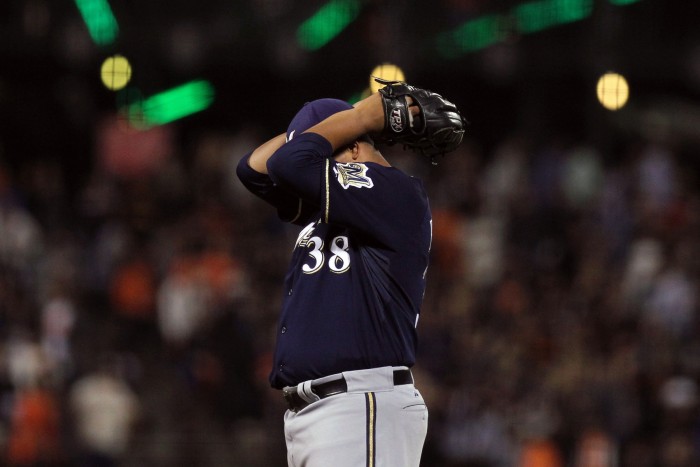On Tuesday, I wrote about the best pitches that we saw from the Brewers in 2015. Jimmy Nelson’s curveball, Ariel Pena’s four-seam fastball, Francisco Rodriguez’s changeup, and Will Smith’s slider all separated themselves from the pack in a good way. Now, we come to the natural compliment to that exercise — which Milwaukee offerings proved to be the worst in 2015? We’ll use the same methodology and metrics from the previous post, along with a new measure that reinforces one of our conclusions.
Stuff
We saw earlier that Nelson took the cake in terms of velocity, while Pena’s movement paced the team. On the other end of the spectrum, there was no such divide — one pitch had both the lowest velocity z-score and the lowest total movement z-score:
| Player | Pitch Type | Velo | z_Velo | HMov | z_HMov | VMov | z_VMov | z_Mov |
|---|---|---|---|---|---|---|---|---|
| Mike Fiers | Curve | 72.7 | -1.85 | 3.9 | -0.61 | -12.0 | -2.78 | -3.4 |
For a curveball, below-average vertical movement isn’t necessarily a bad thing, since the average such pitch already moves negative. Indeed, the fact that Fiers led all starters in curveball drop last season would seem to work in his favor.
Of course, all the dive in the world won’t count for anything if the pitch has no velocity. Only Jered Weaver, Mark Buehrle, and Julio Teheran threw their curveballs slower in 2015, and it showed. Fiers’s curve went for strikes just 43.0 percent of the time in Milwaukee, and when he put it in the zone, hitters such as Tyler Moore made him pay:
Those kinds of dingers made Fiers’s curve worth -1.61 runs below average on a rate basis. The Brewers will miss Fiers overall in 2016, but I for one am glad that his curveball will stay with the Astros.
Run Values
Interestingly enough, though, Fiers’s curve didn’t finish last when it came to Linear Weights. Another starter, who remains on the team, held that distinction:
| Player | Pitch Type | Runs/100 |
|---|---|---|
| Wily Peralta | Fourseam | -2.11 |
Peralta’s 2015 regression fell squarely on the shoulders of his sinker, which traveled nearly a mile and a half slower than it did in 2014. That meant the pitch often resulted in this sort of treatment, courtesy here of Curtis Granderson:
But a run value alone doesn’t really do Peralta justice. For his case, we’ll look at something else.
TAv
Using the same samples from the velocity and whiff rate z-scores, I found the average and standard deviation for each pitch’s resulting TAv. These created TAv z-scores, to better reflect how hard batters hit an offering. They certainly clobbered Peralta’s heater:
| Player | Pitch Type | TAv | z_TAv |
|---|---|---|---|
| Wily Peralta | Fourseam | .392 | 2.38 |
How bad was this? The next-worst pitch, Tyler Cravy’s four-seamer, had a TAv 1.75 standard deviations over the mean. Only Vidal Nuno and Sean O’Sullivan allowed opponents to abuse them more than this. Let’s throw in another GIF of this atrocity, for good measure:
I discussed Peralta’s meltdown in December, noting that the movement of his pitches actually improved in 2015. Let’s hope for his sake that he regains his velocity, because if he doesn’t, the 2016 campaign will bring more of the same kind of pain.
Whiffs
When it comes to swinging strikes, things get complicated. Unlike Fiers’s curveball and Peralta’s four-seamer, this pitch actually held its own in 2015:
| Player | Pitch Type | Whiff% | z_Whiff% |
|---|---|---|---|
| Michael Blazek | Curve | 11.3% | -1.40 |
Blazek didn’t earn many whiffs with the curveball, yet it still gave him 1.99 runs above an average pitch (per 100 appearances). That’s because it accrued its strikes a different way:
Matt Carpenter and his fellow batters took the curveball for a called strike 30.7 percent of the time, an incredible amount. An exercise like this has limits, as Blazek demonstrates — no one metric can really capture all the value of a pitch.
That isn’t to say, however, that Peralta’s four-seamer didn’t struggle, or that Fiers performed well with his curveball. We can pretty conclusively deem one of those two the worst Brewers pitch of 2015. Hopefully, 2016 will bring more pitches like the ones we saw on Thursday (although, if the team continues this rebuild, we won’t witness great pitching for a few years).
Click here for a complete spreadsheet of all 39 pitches.
